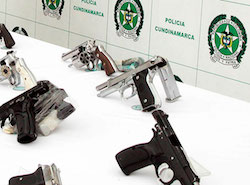Colombia has extended a nationwide ban on carrying firearms until the end of 2016, an attempt to reduce violent deaths at a time the nation is attempting to consolidate peace.
On January 19, Colombian President Juan Manuel Santos announced that an executive decree banning carrying firearms in public would continue until the end of this year. The ban was originally in place from December 23, 2015, through January 31.
According to BBC Mundo, it is the first time Colombia has implemented a nationwide ban against carrying of weapons. Previous bans have been limited to specific geographic regions, such as certain districts of Bogotá, and were shorter in duration.
Santos said the initial December to January restriction had produced positive results towards reducing homicides, saving many lives. During this period, Colombian Minister of Defense Luis Carlos Villegas said homicides fell 13 percent when compared to the same period in 2015.
Hoping to usher in an era where disputes are resolved peacefully, Villegas said the 2016 weapons restriction is intended to address two problems.
The first is homicides resulting from arguments and committed using a firearm. Colombia has issued 500,000 carry permits for firearms and another 400,000 possession permits; meaning roughly one in 53 citizens has a weapons permit. Santos’ decree reverts all carry permits to possession permits, meaning firearms can no longer be carried in public except in certain cases.
According to the government, the weapons restriction is also meant to control illegal firearms on the streets and facilitate the work of security forces. There are an estimated 2.5 million illegal firearms circulating in Colombia, which includes those used by guerrilla groups, criminal bands, and other illicit organizations.
Jorge Restrepo, the director of Colombia’s Center for the Study and Analysis of Conflict (Centro de Estudios para el Análisis de Conflictos – CERAC), expects the decree to decrease the use of firearms in committing homicides by around 20 percent during 2016.
According to Ministry of Defense data cited by BBC Mundo, a firearm is involved in 82 percent of violent deaths in Colombia.
InSight Crime Analysis
The timing of Santos’ decree restricting the public carry of firearms seems significant.
For one, in many respects, Colombia is safer and less violent than at any point in the last decade; the country’s homicide rate has been declining since hitting 69 per 100,000 in 2002, falling to 25 per 100,000 in 2015.
At the moment, it is unclear if, or how, Colombian security forces will step up enforcement to deter carrying of firearms in public. It is also worth asking whether such measures may have a significant impact in reducing gun violence, especially given the large number of unregistered weapons in Colombia to begin with. For instance, as BBC Mundo points out, Brazil implemented a permanent carry ban in 2003, but has seen little improvement to its homicide rates in the years since.
SEE ALSO: Colombia News and Profiles
Notably, the Colombian government is in the final stretch of peace negotiations with the guerrilla Revolutionary Armed Forces of Colombia (Fuerzas Armadas Revolucionarias de Colombia – FARC). If a peace deal is signed, the FARC will turn in their weapons and transition to politics.
However, the FARC’s previous attempt at engaging in mainstream politics — through the founding of the Patriotic Union (Unión Patriótica – UP) party in the mid-1980s — ended poorly, with numerous party leaders killed by right-wing paramilitaries. It’s also plausible that Santos’ decree is a means of guaranteeing the security of demobilized FARC members and preventing such events from happening again, which could once again derail the peace process.

